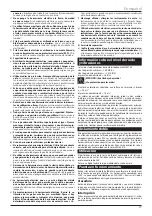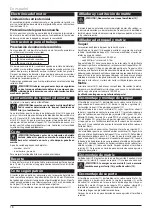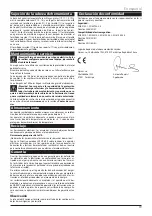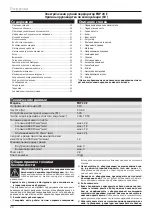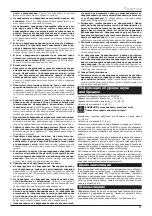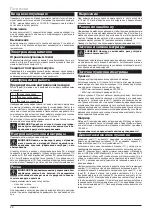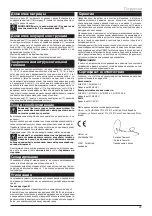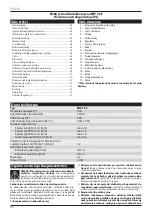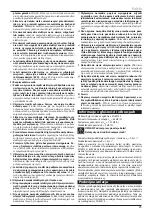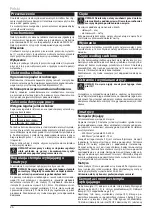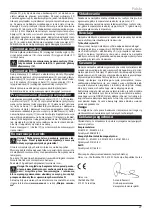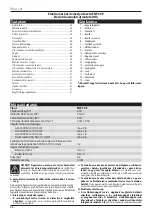
English
13
d)
Do not abuse the cord. Never use the cord for carrying,
pulling or unplugging the power tool. Keep cord away
from heat, oil, sharp edges or moving parts.
Damaged or
entangled cords increase the risk of electric shock.
e)
When operating a power tool outdoors, use an extension
cord suitable for outdoor use.
Use of a cord suitable for out-
door use reduces the risk of electric shock.
f)
If operating a power tool in a damp location is unavoida-
ble, use a residual current device (RCD) protected supply.
Use of an RCD reduces the risk of electric shock.
3) Personal safety
a)
Stay alert, watch what you are doing and use common
sense when operating a power tool. Do not use a power
tool while you are tired or under the influence of drugs,
alcohol or medication.
A moment of inattention while oper-
ating power tools may result in serious personal injury.
b)
Use personal protective equipment. Always wear eye pro-
tection.
Protective equipment such as dust mask, non-skid
safety shoes, hard hat, or hearing protection used for appro-
priate conditions will reduce personal injuries.
c)
Prevent unintentional starting. Ensure the switch is in the
off-position before connecting to power source and/or bat-
tery pack, picking up or carrying the tool.
Carrying power
tools with your finger on the switch or energising power tools
that have the switch on invites accidents.
d)
Remove any adjusting key or wrench before turning the
power tool on.
A wrench or a key left attached to a rotating
part of the power tool may result in personal injury.
e)
Do not overreach. Keep proper footing and balance at all
times.
This enables better control of the power tool in unex-
pected situations.
f)
Dress properly. Do not wear loose clothing or jewellery.
Keep your hair, clothing and gloves away from moving
parts.
Loose clothes, jewellery or long hair can be caught in
moving parts.
g)
If devices are provided for the connection of dust extrac-
tion and collection facilities, ensure these are connected
and properly used.
Use of dust collection can reduce dust-re-
lated hazards.
4) Power tool use and care
a)
Do not force the power tool. Use the correct power tool for
your application.
The correct power tool will do the job better
and safer at the rate for which it was designed.
b)
Do not use the power tool if the switch does not turn it on
and off.
Any power tool that cannot be controlled with the
switch is dangerous and must be repaired.
c)
Disconnect the plug from the power source and/or the
battery pack from the power tool before making any ad-
justments, changing accessories, or storing power tools.
Such preventive safety measures reduce the risk of starting
the power tool accidentally.
d)
Store idle power tools out of the reach of children and
do not allow persons unfamiliar with the power tool or
these instructions to operate the power tool.
Power tools
are dangerous in the hands of untrained users.
e) M
aintain power tools. Check for misalignment or binding
of moving parts, breakage of parts and any other condi-
tion that may affect the power tool’s operation. If dam-
aged, have the power tool repaired before use.
Many acci-
dents are caused by poorly maintained power tools.
f)
Keep cutting tools sharp and clean.
Properly maintained
cutting tools with sharp cutting edges are less likely to bind
and are easier to control..
g)
Use the power tool, accessories and tool bits etc. in ac-
cordance with these instructions, taking into account the
working conditions and the work to be performed.
Use of
the power tool for operations different from those intended
could result in a hazardous situation.
5) Service
a)
Have your power tool serviced by a qualified repair person
using only identical replacement parts.
This will ensure that
the safety of the power tool is maintained.
Information about noise level and
vibrations
The values have been measured in conformity with EN 60745.
Acoustic pressure level L
pA
= 88 dB (A).
Acoustic power level L
wA
= 101 dB (A).
In accuracy of measurements K = 2 dB (A).
ATTENTION! Noise is generated during work!
Use ear protection!
The weighted value of vibrations affecting hands and arms
a
h
= 2.5 m.s
‑2
.
In accuracy of measurements K = 1.5 m.s
‑2
.
The emission values specified (vibration, noise) were measured in
accordance with the test conditions stipulated in EN 60745 and are
intended for machine comparisons. They are also used for making
preliminary estimates regarding vibration and noise loads during
operation.
The emission values specified refer to the main applications for
which the power tool is used. If the electric power tool is used for
other applications, with other tools or is not maintained sufficient‑
ly prior to operation, however, the vibration and noise load may be
higher when the tool is used.
Take into account any machine idling times and downtimes to esti‑
mate these values more accurately for a specified time period. This
may significantly reduce the load during the machine operating
period.
Double insulation
To ensure maximum safety of the user, our tools are designed and
built to satisfy applicable European standards (EN standards). Tools
with double insulation are marked by the international symbol of
a double square. These tools must not be grounded and a two‑wire
cable is sufficient to supply them with power. Tools are shielded in
accordance with EN 55014.
Use
The punch is used to cut out optional shapes without edge distor‑
tion or deformation. It enables cutting out boards and 360° rota‑
tion during operation.
User is liable for any unauthorized use.
Putting into operation
Check whether the data on the rating plate match with the real
power supply voltage. The tool intended for 230 V~ may be also
connected to 220/240 V~. Check whether the plug type corre‑
sponds to the socket type.
Power On
Slide the switch button (1) forward to turn the machine on. If you
press the front part of the button it will lock, thus achieving con‑
stant run.
Power Off
Press the rear part of the switch button shortly (1) to unlock the
button and return it to the Off position by the pressure of the
spring.
Motor electronics
Starting current limitation
Electronically controlled continual running secures device acceler‑
ation without back thrust. Due to starting current limitation in the
device, 10 A protection is sufficient.
Protection against restarting
Prevent uncontrolled starting of the device after current supply cut
off. For restarting, the device must be first switched off and again
switched on.

















